|
|
|
GOETZ ,Henri (New York 1909 - Nizza 1989),
Senza titolo
Carborundum e acquaforte Firma e numerazione a matita. Timbro a secco dello stampatore Giorgio Upiglio. Carta Goya. Esemplare 5/25. cm 27,5x17,5 (Foglio 51,5x36). . . Ottimo (Fine). . Tiratura 25. .

|
|
|
Goffiné, Leonhard:
Catholicas instructiuns dil R. P. (Leonhard) Goffine Praemonstratenser ner cuortas explicatiuns dilgs evangelis sin tuttas domengias ... translatadas in ramonsch entras Gion Evangelist Riedi.
2 Teile in 1 Band. Cuera, Pradella, 1823. 8". XII, 418, 263, (5) S. Halblederband der Zeit in Pappschuber.
书商的参考编号 : 7180CB
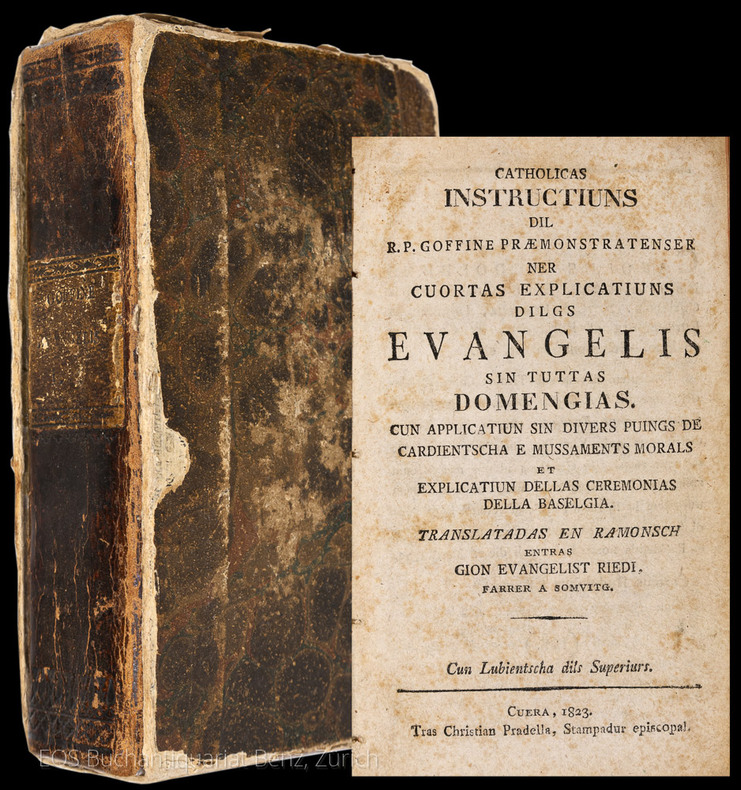
|
|
|
Goffiné, Leonhard
Catholicas instructiuns dil R. P. (Leonhard) Goffine Praemonstratenser ner cuortas explicatiuns dilgs evangelis sin tuttas domengias ... translatadas in ramonsch entras Gion Evangelist Riedi.
Cuera, Pradella, 1823. 8". XII, 418, 263, (5) S. Halblederband der Zeit in Pappschuber. + Wichtig: Für unsere Kunden in der EU erfolgt der Versand alle 14 Tage verzollt ab Deutschland / Postbank-Konto in Deutschland vorhanden +, A 2 Teile in 1 Band.
书商的参考编号 : 7180CB

|
|
|
GOIA, Giuseppe (Monfalcone 1947),
Senza titolo
Acquaforte Carta Pescia. Firma a matita. Esemplare 4/90. Cm 35x24. . . . . Tiratura 90 + X. .

|
|
|
Gollomb, Joseph:
Albert Schweitzer: Genius in der Wildnis.
Olten-Stuttgart-Salzburg, Fackelvlg, o.J. 8°. 286 S. Geb.
书商的参考编号 : 2918AB
|
|
|
GOLTZIUS Hendrik
La Paresse
De la série des 7 péchés capitaux. Bartsch T. III n° 277 Gravé par, ou sous la direction de Jacques Matham.Rogné aux filets d’encadrement, légende en pied. Belle épreuve avec inscription au dos : Claude Augustin Mariette XVIIè 22 x 14,5
书商的参考编号 : 5360
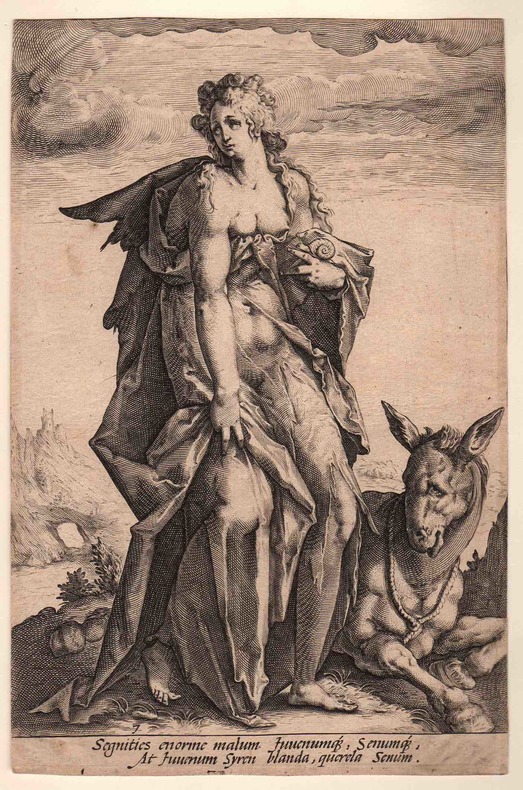
|
|
|
GOLTZIUS Hendrik
La Gourmandise
De la série des 7 péchés capitaux. Bartsch T. III n° 272 Gravé par, ou sous la direction de Jacques Matham. Très petites marges, légende en pied, contrecollé anciennement. Tache en haut à gauche. XVIIè 22 x 14,5
书商的参考编号 : 5361
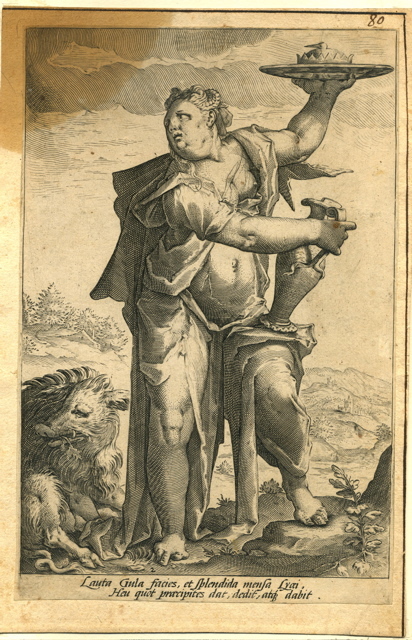
|
|
|
GOLTZIUS Hendrik
La Gourmandise
De la série des 7 péchés capitaux. Bartsch T. III n° 272 Gravé par, ou sous la direction de Jacques Matham. Rogné aux filets d’encadrement, légende en pied. Belle épreuve avec inscription au dos : Claude Augustin Mariette XVIIè 22 x 14,5
书商的参考编号 : 5362

|
|
|
GOLTZIUS Hendrik
La Luxure ( L’ Impureté )
De la série des 7 péchés capitaux. Bartsch T. III n° 273 Gravé par, ou sous la direction de Jacques Matham. Marges insignifiantes, sans la légende dans la marge inférieure. Belle épreuve. XVIIè 22 x 14,5
书商的参考编号 : 5364
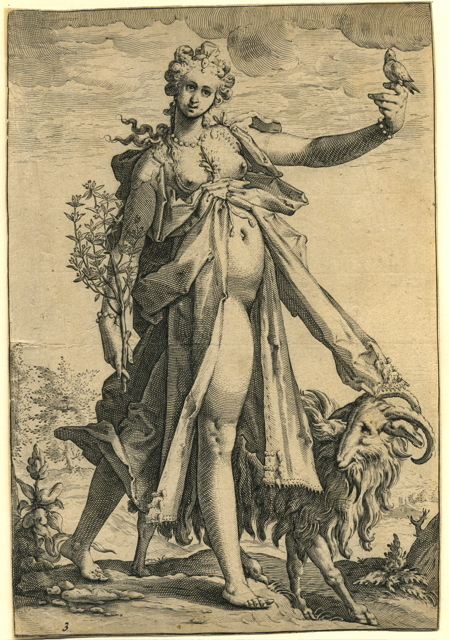
|
|
|
GOLTZIUS Hendrik
La Tempérance
De la série des 7 vertus. Bartsch T. III n° 270 Gravé par, ou sous la direction de Jacques Matham. Rogné aux filets d’encadrement, légende en pied. Contrecollé anciennement. Taches d’encre anciennes pour cacher le corps nu. XVIIè 22 x 14,5
书商的参考编号 : 5367
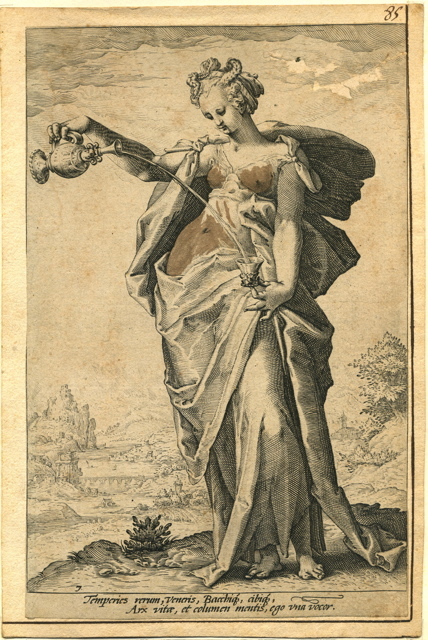
|
|
|
GOLTZIUS Hendrik
La Tempérance
Bartsch T. III n° 123. Suite de sept estampes : les Vertus. Gravé par Jacques Matham. Belle épreuve contrecollée anciennement. XVIIè 15,2 x 10,4
书商的参考编号 : 5369
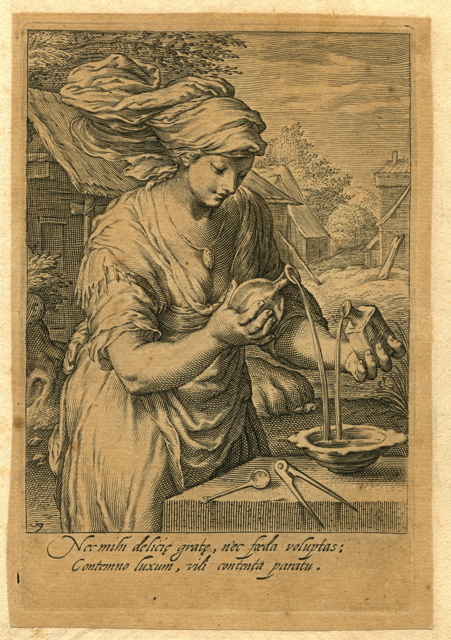
|
|
|
GOLTZIUS Hendrik
L’ Avarice
De la série des 7 péchés capitaux. Bartsch T. III n° 276 Gravé par, ou sous la direction de Jacques Matham. Rogné aux filets d’encadrement, légende en pied. Belle épreuve avec inscription au dos : Claude Augustin Mariette XVIIè 22 x 14,5
书商的参考编号 : 5366
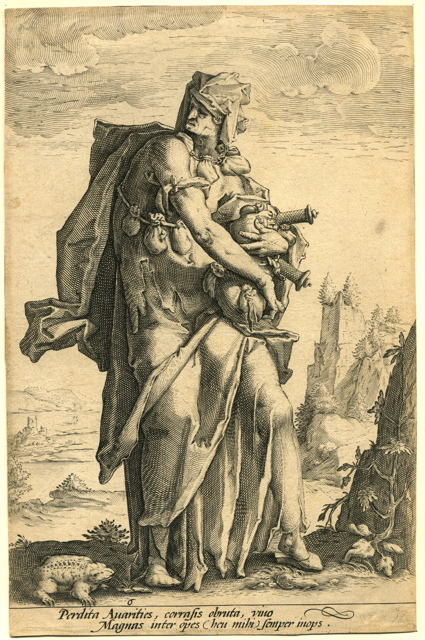
|
|
|
Golf. –
Serendipity. For the Friends of Sunflower Ltd.
Zürich, Conzett Verlag, 1998. 4° (quadratisch). (40) Blatt mit zahlreichen Abb. nach Fotografien von Brian Morgan und Barbara Stucki. Aufklappbarer Orig.-Lederband.
书商的参考编号 : 30686AB

|
|
|
Goldman Paul; British Museum. Dept. of Prints and Drawings
Shadow of the forest: Prints of the Barbizon School
London England: British Museum 1993. Softcover. VG slight bends at top of spine and lower corner. White wraps BW pictorial. 61 pp. Profuse BW illustrations. Catalogue of a touring loan exhibition at Glynn Vivian Art Gallery and Museum Swansea 13 March-24 April 1993; Ashmolean Museum Oxford 25 May-18 July 1993; National Gallery of Scotland Edinburgh 7 October-19 December 1993; and Whitworth Art Gallery Manchester 14 January-5 March 1994. Includes works by Jules Dupre Henri Harpignies Jules Michelin Adolphe Appian Charles Jacque Paul Huet Daubigny Rousseau Millet Corot many others. British Museum paperback
书商的参考编号 : 130195 ???????? : 0861599985 9780861599981

|
|
|
Goldman Paul; British Museum. Dept. of Prints and Drawings
Shadow of the forest: Prints of the Barbizon School
London England: British Museum 1993. Softcover. VG slight bends at top of spine and lower corner. White wraps BW pictorial. 61 pp. Profuse BW illustrations. Catalogue of a touring loan exhibition at Glynn Vivian Art Gallery and Museum Swansea 13 March-24 April 1993; Ashmolean Museum Oxford 25 May-18 July 1993; National Gallery of Scotland Edinburgh 7 October-19 December 1993; and Whitworth Art Gallery Manchester 14 January-5 March 1994. Includes works by Jules Dupre Henri Harpignies Jules Michelin Adolphe Appian Charles Jacque Paul Huet Daubigny Rousseau Millet Corot many others. British Museum paperback books
书商的参考编号 : 130195 ???????? : 0861599985 9780861599981

|
|
|
Goldsmith, Oliver
The Deserted Village
A clean, unmarked book with a tight binding. Green cloth spine and gilt title and holly decoration on front cover. Edge wear and peeling paper on edges of cover.6 1/2"w x7 7/8"h. 46 pages. Black and white illustrations by Hammatt Billings. No date; circa 1890's.

|
|
|
Gollomb, Joseph
Albert Schweitzer: Genius in der Wildnis.
Olten-Stuttgart-Salzburg, Fackelvlg, o.J. 8°. 286 S. Geb. + Wichtig: Für unsere Kunden in der EU erfolgt der Versand alle 14 Tage verzollt ab Deutschland / Postbank-Konto in Deutschland vorhanden +
书商的参考编号 : 2918AB
|
|
|
Gomier, Louis.
Sine Macula. Wohl Rom, um 1730.
Gestochene Kupferplatte (117:174 mm). Hübsches Bildnis der Madonna in Andacht, mit über die Brust gelegten Händen, nach einem Gemälde von Carlo Maratti (1625-1713). Signiert vom Pariser Kupferstecher Louis Gomier, der 1713-30 in Rom tätig war und auch nach Pietro da Cortona, Ciro Ferri und An. Carracci stach. "Zu seinen Hauptblättern gehören eine Ansicht der Bernini-Fontände und des Obelisken auf der Piazza Navona [...] Auch war er Mitarbeiter an Mich. Mercati's Metallotheca [...] und stach einige Porträts nach eigener Zeichnung, darunter die der Königin Marie Eleonore Jos. von Polen und des Fürsten Lubomirski" (Thieme/B. 14, 364). Die Platte trägt noch den Verlegervermerk "typis Salmoni" (wohl ein Hinweis auf den römischen Drucker Giovanni Generoso Salmoni?).
|
|
|
GONCOURT Edmond de.
Outamaro - Le peintre des maisons vertes. Troisème mille.
1904 Paris, Bibliothèque Charpentier, Fasquelle éditeur, 1904; in-18° demi-basane bleu-nuit à coins, dos à nerfs muet, gardes et contreplats bleu vif, 1er plat de la couverture conservé; (2)ff., III, 265, (1)pp.
书商的参考编号 : 10007
|
|
|
Gonzalez Gerth Miguel with preface by Richmond Lattimore & wood engravings by John Roy
The Infinite Absence: poems
Iowa City: Printed for the author at The Stone Wall Press 1964. Hardcover. 20p. 8x5 inches landscape layout preface woodcuts tissue guards rubricated title page #169/250 limited first edition thus in sewn blue boards and gilt. Printed for the author at The Stone Wall Press hardcover
书商的参考编号 : 240569

|
|
|
Gonzalez Gerth Miguel with preface by Richmond Lattimore & wood engravings by John Roy
The Infinite Absence: poems
Iowa City: Printed for the author at The Stone Wall Press 1964. Hardcover. 20p. 8x5 inches landscape layout preface woodcuts tissue guards rubricated title page #169/250 limited first edition thus in sewn blue boards and gilt. Printed for the author at The Stone Wall Press hardcover books
书商的参考编号 : 240569

|
|
|
Goppelsröder, Friedrich:
Ueber die chemische Beschaffenheit von Basel's Grund-, Bach-, Fluss- & Quell-Wasser. Mit besonderer Berücksichtigung der sanitarischen Frage.
Basel, Schweighauserische Verlagsbuchhandlung, 1867. 8°. 97 S. Mit 9 Falttabellen. Pappband der Zeit (Rücken mit kleinen Rissen u. Materialverlust, berieben u. bestossen).
书商的参考编号 : 22500AB
|
|
|
Goppelsröder, Friedrich
Ueber die chemische Beschaffenheit von Basel's Grund-, Bach-, Fluss- & Quell-Wasser. Mit besonderer Berücksichtigung der sanitarischen Frage.
Basel, Schweighauserische Verlagsbuchhandlung, 1867. 8°. 97 S. Mit 9 Falttabellen. Pappband der Zeit (Rücken mit kleinen Rissen u. Materialverlust, berieben u. bestossen). + Wichtig: Für unsere Kunden in der EU erfolgt der Versand alle 14 Tage verzollt ab Deutschland / Postbank-Konto in Deutschland vorhanden +
书商的参考编号 : 22500AB
|
|
|
GORSE (P.)
[Estampe]. Manifestation religieuse et nationale à Notre-Dame de Lourdes. (Le 6 octobre 1872). [Lithographie originale].
Paris, Becquet, (1873). 64,2 x 44,2 cm à la composition + marges.
书商的参考编号 : 19854
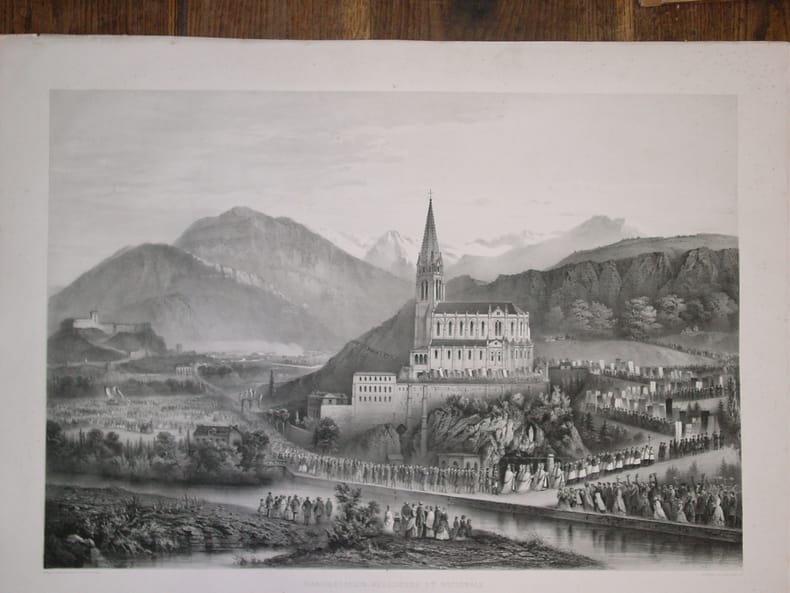
|
|
|
Gordon, Ayala [Curator]
Homage to the Jerusalem Print Workshop [IN HEBREW AND ENGLISH]
IN HEBREW AND ENGLISH. 21.5X21.5 cm. Unnumbered pages. Softcover. In good condition.
|
|
|
Gore Mrs.; Thomas Allom engravings
PARIS IN 1841 BY MRS. GORE
London 1842 first edition Longman Brown Gree. Hardcover. Large octavo 268p. illustrated with 21 engravings by Allom original lime green cloth with full floral gilt trim and original yellow end papers. All edges gilt. Good Plus light foxing on initial pages and on some of the plates spine faded to tan. Uneven discoloration on cover cloth. Binding secure; no ownership marks. . hardcover
书商的参考编号 : a88179
|
|
|
Gorelik, Sch. / Budko, Joseph [Artist] / Goldenring, Stefania; Strasser, Nadia [Tr.]
Jüdische Köpfe [WITH FOUR ORIGINAL LITHOGRAPHS]. Lithographien von Joseph Budko.
RARE book illustrated by Joseph Budko (1888-1940) - one of the greatest Jewish graphic artists, who started the revival of woodcut and one of the first great modern book illustrators. Includes FOUR ORIGINAL LITHOHRAPHS depicting Theodor Herzl, Marko Baruch, J.L.Perez, and Baruch Spinoza. 295x245mm. 114 pages. Illustrated board Hardcover with gilt cloth spine. Cover yellowing, age-stained, slightly stained and curved. Cover corners and edges bumped and peeling. Spine partly detached from binding (hinges partly cracked). Spine upper edge tattered, bottom edge missing. Ink writing on front whitepage upper edge. Inner cover and pages age-stained to various degrees. Some pages upper edge water-stained - no damage to text or plates. Pages yellowing, wavy and rough-cut (as published). [SUMMARY]: This extremely rare book with four original lithographs by one of the greatest modern Jewish artists is otherwise in good condition.
|
|
|
Gorr, Shmuel / Gelman, Manuel / Pins, Jacob [Illustr.]
Out of The Depths: Selected Poems and Essays [SIGNED AND DEDICATED BY AUTHOR'S SISTER] Limited Edition. Introduction by Manuel Gelman. Illustrated by Jacob Pins.
220x140mm. 20 pages. Gilt softcover. Inner cover illustrated. Cover corners/edges and spine edges slightly worn. Else in good condition.
|
|
|
GOSE Francisco Javier
Il a été primé. Robe du soir (pl.21, La Gazette du Bon ton, 1914 n°3)
- Lucien Vogel éditeur, Paris Mars 1914, 19x24,5cm, une feuille. - Original color print, printed on vergé paper, signed in the plate. An original print used to illustrate the Gazette du bon ton, one of the most attractive and influential 20th century fashion magazines, featuring the talents of French artists and other contributors from the burgeoning Art Deco movement. A celebrated fashion magazine established in 1912 by Lucien Vogel, La Gazette du bon ton appeared until 1925, with a hiatus from 1915 to 1920 due to the war (the editor-in-chief having been called up for service). It consisted of 69 issues printed in only 2,000 copies each and notably illustrated with 573 color plates and 148 sketches of the models of the great designers. Right from the start, this sumptuous publication "was aimed at bibliophiles and fashionable society," (Françoise Tétart-Vittu, "La Gazette du bon ton", in Dictionnaire de la mode, 2016) and was printed on fine vergé paper using a type cut specially for the magazine by Georges Peignot, known as Cochin, later used (in 1946) by Christian Dior. The prints were made using stencils, heightened in colors, some highlighted in gold or palladium. The story began in 1912, when Lucien Vogel, a man of the world involved in fashion (he had already been part of the fashion magazine Femina) decided, with his wife Cosette de Brunhoff - the sister of Jean, creator of Babar - to set up the Gazette du bon ton, subtitled at the time: "Art, fashion, frivolities." Georges Charensol noted the reasoning of the editor-in-chief: "'In 1910,' he observed, 'there was no really artistic fashion magazine, nothing representative of the spirit of the time. My dream was therefore to make a luxury magazine with truly modern artists...I was assured of success, because when it comes to fashion, no country on earth can compete with France.'" ("Un grand éditeur d'art. Lucien Vogel" in Les Nouvelles littéraires, no. 133, May 1925). The magazine was immediately successful, not only in France but also in the United States and Latin America. At first, Vogel put together a team of seven artists: André-Édouard Marty and Pierre Brissaud, followed by Georges Lepape and Dammicourt, as well as eventually his friends from school and the School of Fine Arts, like George Barbier, Bernard Boutet de Monvel and Charles Martin. Other talented people soon came flocking to join the team: Guy Arnoux, Léon Bakst, Benito, Boutet de Monvel, Umberto Brunelleschi, Chas Laborde, Jean-Gabriel Domergue, Raoul Dufy, Édouard Halouze, Alexandre Iacovleff, Jean Émile Laboureur, Charles Loupot, Chalres Martin, Maggie Salcedo. These artist, mostly unknown when Lucien Vogel sought them out, later became emblematic and sought-after artistic figures. It was also they who worked on the advertising drawings for the Gazette. The plates put the spotlight on, and celebrate, dresses by seven designers of the age: Lanvin, Doeuillet, Paquin, Poiret, Worth, Vionnet and Doucet. The designers provided exclusive models for each issue. Nonetheless, some of the illustrations are not based on real models, but simply on the illustrator's conception of the fashion of the day. The Gazette du bon ton was an important step in the history of fashion. Combining aesthetic demands with the physical whole, it brought together - for the first time - the great talents of the artistic, literary, and fashion worlds; and imposed, through this alchemy, a completely new image of women: slender, independent and daring, which was shared by the new generation of designers, including Coco Chanel, Jean Patou, Marcel Rochas, and so on... Taken over in 1920 by Condé Montrose Nast, the Gazette du bon ton was an important influence on the new layout and aesthetics of that "little dying paper" that Nast had bought a few years earlier: Vogue. [FRENCH VERSION FOLLOWS] Estampe originale en couleur, tirée sur papier vergé, signée en bas à droite de la planche. Gravure originale réalisée pour l'il

|
|
|
GOSE Francisco Javier
Les Premières Roses. Costume Tailleur pour le matin (pl.2, La Gazette du Bon ton, 1912-1913 n°5)
- Lucien Vogel éditeur, Paris Mars 1913, 19x24,5cm, une feuille. - Original color print, printed on vergé paper, signed in the plate. An original print used to illustrate the Gazette du bon ton, one of the most attractive and influential 20th century fashion magazines, featuring the talents of French artists and other contributors from the burgeoning Art Deco movement. A celebrated fashion magazine established in 1912 by Lucien Vogel, La Gazette du bon ton appeared until 1925, with a hiatus from 1915 to 1920 due to the war (the editor-in-chief having been called up for service). It consisted of 69 issues printed in only 2,000 copies each and notably illustrated with 573 color plates and 148 sketches of the models of the great designers. Right from the start, this sumptuous publication "was aimed at bibliophiles and fashionable society," (Françoise Tétart-Vittu, "La Gazette du bon ton", in Dictionnaire de la mode, 2016) and was printed on fine vergé paper using a type cut specially for the magazine by Georges Peignot, known as Cochin, later used (in 1946) by Christian Dior. The prints were made using stencils, heightened in colors, some highlighted in gold or palladium. The story began in 1912, when Lucien Vogel, a man of the world involved in fashion (he had already been part of the fashion magazine Femina) decided, with his wife Cosette de Brunhoff - the sister of Jean, creator of Babar - to set up the Gazette du bon ton, subtitled at the time: "Art, fashion, frivolities." Georges Charensol noted the reasoning of the editor-in-chief: "'In 1910,' he observed, 'there was no really artistic fashion magazine, nothing representative of the spirit of the time. My dream was therefore to make a luxury magazine with truly modern artists...I was assured of success, because when it comes to fashion, no country on earth can compete with France.'" ("Un grand éditeur d'art. Lucien Vogel" in Les Nouvelles littéraires, no. 133, May 1925). The magazine was immediately successful, not only in France but also in the United States and Latin America. At first, Vogel put together a team of seven artists: André-Édouard Marty and Pierre Brissaud, followed by Georges Lepape and Dammicourt, as well as eventually his friends from school and the School of Fine Arts, like George Barbier, Bernard Boutet de Monvel and Charles Martin. Other talented people soon came flocking to join the team: Guy Arnoux, Léon Bakst, Benito, Boutet de Monvel, Umberto Brunelleschi, Chas Laborde, Jean-Gabriel Domergue, Raoul Dufy, Édouard Halouze, Alexandre Iacovleff, Jean Émile Laboureur, Charles Loupot, Chalres Martin, Maggie Salcedo. These artist, mostly unknown when Lucien Vogel sought them out, later became emblematic and sought-after artistic figures. It was also they who worked on the advertising drawings for the Gazette. The plates put the spotlight on, and celebrate, dresses by seven designers of the age: Lanvin, Doeuillet, Paquin, Poiret, Worth, Vionnet and Doucet. The designers provided exclusive models for each issue. Nonetheless, some of the illustrations are not based on real models, but simply on the illustrator's conception of the fashion of the day. The Gazette du bon ton was an important step in the history of fashion. Combining aesthetic demands with the physical whole, it brought together - for the first time - the great talents of the artistic, literary, and fashion worlds; and imposed, through this alchemy, a completely new image of women: slender, independent and daring, which was shared by the new generation of designers, including Coco Chanel, Jean Patou, Marcel Rochas, and so on... Taken over in 1920 by Condé Montrose Nast, the Gazette du bon ton was an important influence on the new layout and aesthetics of that "little dying paper" that Nast had bought a few years earlier: Vogue. [FRENCH VERSION FOLLOWS] Estampe originale en couleur, tirée sur papier vergé et signée en bas à droite dans la planche. Gravure originale réalisée pour

|
|
|
GOSE Francisco Javier
Suis-je belle ce soir ? Robe pour le casino (pl.63, La Gazette du Bon ton, 1914 n°7)
- Lucien Vogel éditeur, Paris Juillet 1914, 18x24cm, une feuille. - Double original color print, printed on vergé paper, signed in the plate. An original print used to illustrate the Gazette du bon ton, one of the most attractive and influential 20th century fashion magazines, featuring the talents of French artists and other contributors from the burgeoning Art Deco movement. A celebrated fashion magazine established in 1912 by Lucien Vogel, La Gazette du bon ton appeared until 1925, with a hiatus from 1915 to 1920 due to the war (the editor-in-chief having been called up for service). It consisted of 69 issues printed in only 2,000 copies each and notably illustrated with 573 color plates and 148 sketches of the models of the great designers. Right from the start, this sumptuous publication "was aimed at bibliophiles and fashionable society," (Françoise Tétart-Vittu, "La Gazette du bon ton", in Dictionnaire de la mode, 2016) and was printed on fine vergé paper using a type cut specially for the magazine by Georges Peignot, known as Cochin, later used (in 1946) by Christian Dior. The prints were made using stencils, heightened in colors, some highlighted in gold or palladium. The story began in 1912, when Lucien Vogel, a man of the world involved in fashion (he had already been part of the fashion magazine Femina) decided, with his wife Cosette de Brunhoff - the sister of Jean, creator of Babar - to set up the Gazette du bon ton, subtitled at the time: "Art, fashion, frivolities." Georges Charensol noted the reasoning of the editor-in-chief: "'In 1910,' he observed, 'there was no really artistic fashion magazine, nothing representative of the spirit of the time. My dream was therefore to make a luxury magazine with truly modern artists...I was assured of success, because when it comes to fashion, no country on earth can compete with France.'" ("Un grand éditeur d'art. Lucien Vogel" in Les Nouvelles littéraires, no. 133, May 1925). The magazine was immediately successful, not only in France but also in the United States and Latin America. At first, Vogel put together a team of seven artists: André-Édouard Marty and Pierre Brissaud, followed by Georges Lepape and Dammicourt, as well as eventually his friends from school and the School of Fine Arts, like George Barbier, Bernard Boutet de Monvel and Charles Martin. Other talented people soon came flocking to join the team: Guy Arnoux, Léon Bakst, Benito, Boutet de Monvel, Umberto Brunelleschi, Chas Laborde, Jean-Gabriel Domergue, Raoul Dufy, Édouard Halouze, Alexandre Iacovleff, Jean Émile Laboureur, Charles Loupot, Chalres Martin, Maggie Salcedo. These artist, mostly unknown when Lucien Vogel sought them out, later became emblematic and sought-after artistic figures. It was also they who worked on the advertising drawings for the Gazette. The plates put the spotlight on, and celebrate, dresses by seven designers of the age: Lanvin, Doeuillet, Paquin, Poiret, Worth, Vionnet and Doucet. The designers provided exclusive models for each issue. Nonetheless, some of the illustrations are not based on real models, but simply on the illustrator's conception of the fashion of the day. The Gazette du bon ton was an important step in the history of fashion. Combining aesthetic demands with the physical whole, it brought together - for the first time - the great talents of the artistic, literary, and fashion worlds; and imposed, through this alchemy, a completely new image of women: slender, independent and daring, which was shared by the new generation of designers, including Coco Chanel, Jean Patou, Marcel Rochas, and so on... Taken over in 1920 by Condé Montrose Nast, the Gazette du bon ton was an important influence on the new layout and aesthetics of that "little dying paper" that Nast had bought a few years earlier: Vogue. [FRENCH VERSION FOLLOWS] Estampe double originale en couleur, tirée sur papier vergé, signée en bas à droite de la planche. Gravure originale réa

|
|
|
GOSE Georges
L'Arbre de mai. Robes simples pour l'été (pl.42, La Gazette du Bon ton, 1914 n°5)
- Lucien Vogel éditeur, Paris Mai 1914, 36,5x24cm, une feuille. - Double original color print heightened with gold, printed on vergé paper, signed in the plate. An original print used to illustrate the Gazette du bon ton, one of the most attractive and influential 20th century fashion magazines, featuring the talents of French artists and other contributors from the burgeoning Art Deco movement. A celebrated fashion magazine established in 1912 by Lucien Vogel, La Gazette du bon ton appeared until 1925, with a hiatus from 1915 to 1920 due to the war (the editor-in-chief having been called up for service). It consisted of 69 issues printed in only 2,000 copies each and notably illustrated with 573 color plates and 148 sketches of the models of the great designers. Right from the start, this sumptuous publication "was aimed at bibliophiles and fashionable society," (Françoise Tétart-Vittu, "La Gazette du bon ton", in Dictionnaire de la mode, 2016) and was printed on fine vergé paper using a type cut specially for the magazine by Georges Peignot, known as Cochin, later used (in 1946) by Christian Dior. The prints were made using stencils, heightened in colors, some highlighted in gold or palladium. The story began in 1912, when Lucien Vogel, a man of the world involved in fashion (he had already been part of the fashion magazine Femina) decided, with his wife Cosette de Brunhoff - the sister of Jean, creator of Babar - to set up the Gazette du bon ton, subtitled at the time: "Art, fashion, frivolities." Georges Charensol noted the reasoning of the editor-in-chief: "'In 1910,' he observed, 'there was no really artistic fashion magazine, nothing representative of the spirit of the time. My dream was therefore to make a luxury magazine with truly modern artists...I was assured of success, because when it comes to fashion, no country on earth can compete with France.'" ("Un grand éditeur d'art. Lucien Vogel" in Les Nouvelles littéraires, no. 133, May 1925). The magazine was immediately successful, not only in France but also in the United States and Latin America. At first, Vogel put together a team of seven artists: André-Édouard Marty and Pierre Brissaud, followed by Georges Lepape and Dammicourt, as well as eventually his friends from school and the School of Fine Arts, like George Barbier, Bernard Boutet de Monvel and Charles Martin. Other talented people soon came flocking to join the team: Guy Arnoux, Léon Bakst, Benito, Boutet de Monvel, Umberto Brunelleschi, Chas Laborde, Jean-Gabriel Domergue, Raoul Dufy, Édouard Halouze, Alexandre Iacovleff, Jean Émile Laboureur, Charles Loupot, Chalres Martin, Maggie Salcedo. These artist, mostly unknown when Lucien Vogel sought them out, later became emblematic and sought-after artistic figures. It was also they who worked on the advertising drawings for the Gazette. The plates put the spotlight on, and celebrate, dresses by seven designers of the age: Lanvin, Doeuillet, Paquin, Poiret, Worth, Vionnet and Doucet. The designers provided exclusive models for each issue. Nonetheless, some of the illustrations are not based on real models, but simply on the illustrator's conception of the fashion of the day. The Gazette du bon ton was an important step in the history of fashion. Combining aesthetic demands with the physical whole, it brought together - for the first time - the great talents of the artistic, literary, and fashion worlds; and imposed, through this alchemy, a completely new image of women: slender, independent and daring, which was shared by the new generation of designers, including Coco Chanel, Jean Patou, Marcel Rochas, and so on... Taken over in 1920 by Condé Montrose Nast, the Gazette du bon ton was an important influence on the new layout and aesthetics of that "little dying paper" that Nast had bought a few years earlier: Vogue. [FRENCH VERSION FOLLOWS] Estampe double originale en couleur rehaussée à l'or, tirée sur papier vergé, signée en bas à gauche

|
|
|
GOUDIACHVILI Lado
Marchand de yaourt (pl.40, La Gazette du Bon ton, 1924-1925 n°5)
- Lucien Vogel éditeur, Paris 1924-1925, 18x24cm, une feuille. - Original color print, printed on vergé paper, non signed. An original print used to illustrate the Gazette du bon ton, one of the most attractive and influential 20th century fashion magazines, featuring the talents of French artists and other contributors from the burgeoning Art Deco movement. A celebrated fashion magazine established in 1912 by Lucien Vogel, La Gazette du bon ton appeared until 1925, with a hiatus from 1915 to 1920 due to the war (the editor-in-chief having been called up for service). It consisted of 69 issues printed in only 2,000 copies each and notably illustrated with 573 color plates and 148 sketches of the models of the great designers. Right from the start, this sumptuous publication "was aimed at bibliophiles and fashionable society," (Françoise Tétart-Vittu, "La Gazette du bon ton", in Dictionnaire de la mode, 2016) and was printed on fine vergé paper using a type cut specially for the magazine by Georges Peignot, known as Cochin, later used (in 1946) by Christian Dior. The prints were made using stencils, heightened in colors, some highlighted in gold or palladium. The story began in 1912, when Lucien Vogel, a man of the world involved in fashion (he had already been part of the fashion magazine Femina) decided, with his wife Cosette de Brunhoff - the sister of Jean, creator of Babar - to set up the Gazette du bon ton, subtitled at the time: "Art, fashion, frivolities." Georges Charensol noted the reasoning of the editor-in-chief: "'In 1910,' he observed, 'there was no really artistic fashion magazine, nothing representative of the spirit of the time. My dream was therefore to make a luxury magazine with truly modern artists...I was assured of success, because when it comes to fashion, no country on earth can compete with France.'" ("Un grand éditeur d'art. Lucien Vogel" in Les Nouvelles littéraires, no. 133, May 1925). The magazine was immediately successful, not only in France but also in the United States and Latin America. At first, Vogel put together a team of seven artists: André-Édouard Marty and Pierre Brissaud, followed by Georges Lepape and Dammicourt, as well as eventually his friends from school and the School of Fine Arts, like George Barbier, Bernard Boutet de Monvel and Charles Martin. Other talented people soon came flocking to join the team: Guy Arnoux, Léon Bakst, Benito, Boutet de Monvel, Umberto Brunelleschi, Chas Laborde, Jean-Gabriel Domergue, Raoul Dufy, Édouard Halouze, Alexandre Iacovleff, Jean Émile Laboureur, Charles Loupot, Chalres Martin, Maggie Salcedo. These artist, mostly unknown when Lucien Vogel sought them out, later became emblematic and sought-after artistic figures. It was also they who worked on the advertising drawings for the Gazette. The plates put the spotlight on, and celebrate, dresses by seven designers of the age: Lanvin, Doeuillet, Paquin, Poiret, Worth, Vionnet and Doucet. The designers provided exclusive models for each issue. Nonetheless, some of the illustrations are not based on real models, but simply on the illustrator's conception of the fashion of the day. The Gazette du bon ton was an important step in the history of fashion. Combining aesthetic demands with the physical whole, it brought together - for the first time - the great talents of the artistic, literary, and fashion worlds; and imposed, through this alchemy, a completely new image of women: slender, independent and daring, which was shared by the new generation of designers, including Coco Chanel, Jean Patou, Marcel Rochas, and so on... Taken over in 1920 by Condé Montrose Nast, the Gazette du bon ton was an important influence on the new layout and aesthetics of that "little dying paper" that Nast had bought a few years earlier: Vogue. [FRENCH VERSION FOLLOWS] Estampe originale en couleur, tirée sur papier vergé, non-signée. Gravure originale réalisée pour l'illustration de La Gazette du bon ton

|
|
|
GOUDIACHVILI Lado
Paysage (pl.39, La Gazette du Bon ton, 1924-1925 n°5)
- Lucien Vogel éditeur, Paris 1924-1925, 18x24cm, une feuille. - Original color print, printed on vergé paper, signed in the plate. An original print used to illustrate the Gazette du bon ton, one of the most attractive and influential 20th century fashion magazines, featuring the talents of French artists and other contributors from the burgeoning Art Deco movement. A celebrated fashion magazine established in 1912 by Lucien Vogel, La Gazette du bon ton appeared until 1925, with a hiatus from 1915 to 1920 due to the war (the editor-in-chief having been called up for service). It consisted of 69 issues printed in only 2,000 copies each and notably illustrated with 573 color plates and 148 sketches of the models of the great designers. Right from the start, this sumptuous publication "was aimed at bibliophiles and fashionable society," (Françoise Tétart-Vittu, "La Gazette du bon ton", in Dictionnaire de la mode, 2016) and was printed on fine vergé paper using a type cut specially for the magazine by Georges Peignot, known as Cochin, later used (in 1946) by Christian Dior. The prints were made using stencils, heightened in colors, some highlighted in gold or palladium. The story began in 1912, when Lucien Vogel, a man of the world involved in fashion (he had already been part of the fashion magazine Femina) decided, with his wife Cosette de Brunhoff - the sister of Jean, creator of Babar - to set up the Gazette du bon ton, subtitled at the time: "Art, fashion, frivolities." Georges Charensol noted the reasoning of the editor-in-chief: "'In 1910,' he observed, 'there was no really artistic fashion magazine, nothing representative of the spirit of the time. My dream was therefore to make a luxury magazine with truly modern artists...I was assured of success, because when it comes to fashion, no country on earth can compete with France.'" ("Un grand éditeur d'art. Lucien Vogel" in Les Nouvelles littéraires, no. 133, May 1925). The magazine was immediately successful, not only in France but also in the United States and Latin America. At first, Vogel put together a team of seven artists: André-Édouard Marty and Pierre Brissaud, followed by Georges Lepape and Dammicourt, as well as eventually his friends from school and the School of Fine Arts, like George Barbier, Bernard Boutet de Monvel and Charles Martin. Other talented people soon came flocking to join the team: Guy Arnoux, Léon Bakst, Benito, Boutet de Monvel, Umberto Brunelleschi, Chas Laborde, Jean-Gabriel Domergue, Raoul Dufy, Édouard Halouze, Alexandre Iacovleff, Jean Émile Laboureur, Charles Loupot, Chalres Martin, Maggie Salcedo. These artist, mostly unknown when Lucien Vogel sought them out, later became emblematic and sought-after artistic figures. It was also they who worked on the advertising drawings for the Gazette. The plates put the spotlight on, and celebrate, dresses by seven designers of the age: Lanvin, Doeuillet, Paquin, Poiret, Worth, Vionnet and Doucet. The designers provided exclusive models for each issue. Nonetheless, some of the illustrations are not based on real models, but simply on the illustrator's conception of the fashion of the day. The Gazette du bon ton was an important step in the history of fashion. Combining aesthetic demands with the physical whole, it brought together - for the first time - the great talents of the artistic, literary, and fashion worlds; and imposed, through this alchemy, a completely new image of women: slender, independent and daring, which was shared by the new generation of designers, including Coco Chanel, Jean Patou, Marcel Rochas, and so on... Taken over in 1920 by Condé Montrose Nast, the Gazette du bon ton was an important influence on the new layout and aesthetics of that "little dying paper" that Nast had bought a few years earlier: Vogue. [FRENCH VERSION FOLLOWS] Estampe originale en couleur, tirée sur papier vergé, signée en bas à gauche de la planche. Gravure originale réalisée pour l'illu

|
|
|
Gough John B. John Bartholomew & Steel Engravings
Sunlight and Shadows; or Gleanings from My Life Work Comprising Personal Experiences and Opinions Anecdotes Incidents and Reminiscences Gathered from Thirty-Seven Years; Experience on the Platform and Among the People at Home and Abroad
A.D. Worthington Anc Company. Very Good- with no dust jacket. 1881. Hardcover. 542 pp; Book is sunned on spine slightly shaken wear to corners and spine ends endpapers and tissue covering frontis portrait are foxed. Cover gilt very bright and flat embossed decorative border nice. Still a nice solid and attractive copy. Temperance advocate and speaker based on his personal experiences with alcoholism. . A.D. Worthington Anc Company hardcover
书商的参考编号 : 302243
|
|
|
GOYA Francisco / MICKO Miroslav ( texte de )
LES CAPRICES
Paris Editions Cercle d'Art 1960 in 4 (27,5x21,5) 1 volume reliure toilée de l'éditeur sous jaquette illustrée, 29 pages, suivies des reproductions horrs-texte (légendées en regard) des 80 planches des ''Caprices'' de Goya, et de 16 pages (titres,commentaires de Goya et notes). Bel exemplaire ( Photographies sur demande / We can send pictures of this book on simple request )
书商的参考编号 : 36991
|
|
|
Grandville (Nancy, 15–09–1803 - Vanves, 17–03–1847) -Desperet ou Desperret, Auguste
... empressées 1833 - Lithographie, Coloriée - Voyage de la pensée immuable à travers les populations empressées: 3 -Hand-coloured lithograph,
1833 Planche HT double parue dans La Caricature politique, morale, littéraire et scénique, volume 6, 7 novembre 1833 (n°328-329) : Hauteur: 35.8cmx Largeur: 53cm- Image Hauteur: 22cm x Largeur: 53cmDescription:Titre en ht au centre : « EMPRESSÉES. » ; légendes, en bas, de gche à dte : « L’omnibus trainé [traîné] par les quatre boiteuses. », « Les Débats. », « Le Constitutionnel. », « Le Moniteur. », « Le Journal de Paris. » ; indications : en ht au centre : « La Caricature (Journal) N°157. », en ht à dte : « Pl. 328 et 329. »Inscription - Dans la lettre : « L. de Becquet, rue Furstemberg. 9. » [imprimeur], « Chez Aubert, galerie véro d […] [dodat] » [feuille coupée] [éditeur] ; dans l’image, en bas au centre, signature : « G. invt A.D. » [Jean-Jacques Grandville, dessinateur, et Auguste Desperet, lithographe]Inscription - Sur le nez de d’Argout, inscription : « DE PARIS A LISIEUX ». Sur le devant de la cabine du cocher, le slogan « VIVE LE RÔA » : « le cocher, en appuyant le pied sur un petit buffet d’orgue, peut, au moyen de cet appareil, produire un volume satisfaisant d’amour unanime » (in explication)Description iconographique: Pl. n°5 et 6 du "Voyage de la pensée immuable à travers les populations empressées". Cf. pl. n°1 et 2 (pl. 324-325 du numéro 155) et pl. n°3 et 4 (pl. 326-327 du numéro 156). Les deux dernières pl. de la série montrent « l’auguste omnibus, traîné par ses quatre boiteuses » (in explication), c'est-à-dire un carrosse traîné par des chevaux. Sur le toit du carrosse sont assis, de gche à dte : d’Argout, faisant le cocher, un homme de dos (« M. Faim », in explication), Montalivet habillé en cuisiner et tenant une casserole, et Barthe. L’emblème de la monarchie de Juillet imaginé par Grandville se trouve sur le la petite cabine du cocher : il est constitué d’une grande paire de ciseaux ouverts, entourée d’un parapluie, d’une seringue à clystère, d’un chapeau à cocarde tricolore et d’une toque de magistrat. Deux municipaux, « M. Corneille, adjoint d’Evreux, et M. Criquet, maire de Falaise » (in explication) se cramponnent au carrosse (au marche-pied et à la portière arrière) afin de saluer Madame Adélaïde se trouvant à l’intérieur. L’un d’eux souhaite lui offrir un bouquet de fleurs. Des motifs partiels de poire à face humaine décorent le carrosse. A l’arrière-plan, des petits enfants montés sur les branches d’un arbre lèvent le poing au passage du cortège. Derrière le carrosse suivent les incarnations des journaux, sous la forme d’hommes pourvus d’attributs. Le Journal des débats, portant un pantalon fleurdelysé et une poire sur son bicorne, prend des notes sur un petit carnet. "Le Constitutionnel", écrivant sur un cahier dont le titre a le nom du journal, porte un bonnet et tient une vessie au bout d’un bâton sur laquelle peut se lire « ON SE // DESABONN […] [DESABONNE] » ("La Caricature" se moque fréquemment des désabonnements dont est victime ce journal). Un sac d’argent pend de son pantalon (« 1,000 »). Son encrier, accroché à son vêtement, à la forme du buste de Dupin en habit de magistrat. Enfin, « son araignée dilettante » (in explication) court à côté de lui, au bout d’un fil. Puis vient le "Moniteur", « avec ses plumes d’oie et son appareil vélocipède » (in explication). Il est coiffé d’un chapeau en forme de poire à face humaine. A la bicyclette sont accrochés de nombreux symboles des différents régimes successifs en France : la poire à tête de Louis-Philippe de la monarchie de Juillet, la fleur de lys monarchique (représentée à l’envers), le bonnet phrygien à cocarde tricolore, et l’aigle de l’Empire (représenté à l’envers). La tête d’un homme (non identifié) pend dans son dos. Enfin, le "Journal de Paris" ferme la marche : homme barbu et pourvu de gros favoris, il porte un haut chapeau décoré du motif de la poire à face humaine de Louis-Philippe. Il est décoré de la croix d’honneur. Il porte un gros encrier en bandoulière dans le dos. Il est « le seul journal qui n’écrive point, par l’excellente raison qu’il ne sait pas écrire » (in explication). A l’extrême gche, à l’arrière-plan, des enfants du peuple montés sur des branches d’arbres, lèvent le poing en signe de protestation.
书商的参考编号 : 25194
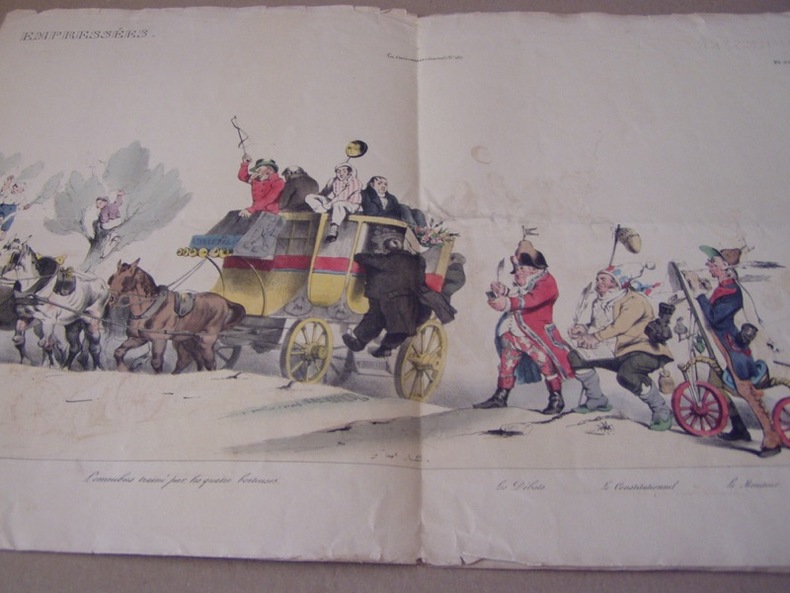
|
|
|
GRANDVILLE et FOREST.[PRESTIDIGITATION].
[PRESTIDIGITATION].- Mr Bosco, prestidigitateur.Lithographie originale sur Velin blanc
1832 1832. Lithographie.[PRESTIDIGITATION]. GRANDVILLE et FOREST. Mr Bosco, prestidigitateur. Pl. 223. 250 x 225. Vic. col. 65.Planche 223 de La Caricature N° 108.La Caricature, 29 novembre 1832. Lithographie originale sur Velin blanc,un peu jaunie,plis
书商的参考编号 : 25105
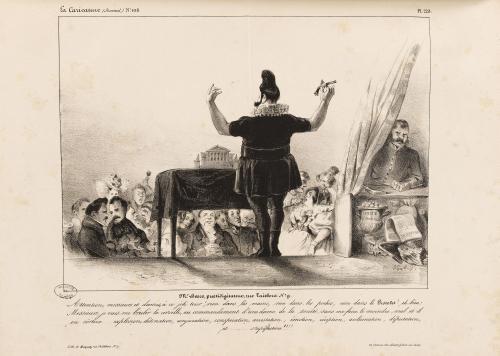
|
|
|
GRAVURE LEVIS (Howard C.)
A descriptive bibliography of the most important books in the english language relating to the art & history of engraving and the collecting of prints with supplement and index.
Folkestone (Kent), Dawsons of Pall Mall, 1974. In-4, rel. d’éditeur pleine toile jaune, dos titré, XIX-571-141 pp., frontispice et ill. en noir in-t. Texte anglais.
书商的参考编号 : 567997 ???????? : 712906398
|
|
|
GRAVURE
Annuaire de la gravure française. 1911.
P., Soc. pour l'Etude de la gravure française, [1911]. In-8 carré, demi-maroquin chagriné brun de l'époque, dos à nerfs titré, tête dorée, couv. conservée, 143 pp., 4 pl. h.-t., dont un bois gravé original d'Auguste Lepère,une xylographie en couleurs de A. Chevallier (dépliante), deux eaux-fortes par Flameng et Legros, en phototypie. Tirage à 650 ex., un des 600 sur vélin d'Arches.
书商的参考编号 : 563588
|
|
|
GRAVURE
Annuaire de la gravure française. 1912.
P., Soc. pour l'Etude de la gravure française, [1912]. In-8 carré, demi-maroquin chagriné brun de l'époque, dos à nerfs titré, tête dorée, couv. conservée, 195 pp., 4 pl. h.-t., une eau-forte par Viala, deux phototypies et un retirage d'après des eaux-fortes originales de J.-B. Oudry et de Paillard. Tirage à 650 ex., un des 600 sur vélin d'Arches.
书商的参考编号 : 563589
|
|
|
Grandville JJ - Forest, Eugène-Hippolyte
Artillerie du diable.Lithographie sur blanc.
1834 Planc he HT parue dans La Caricature politique, morale, littéraire et scénique, volume 7, 20 mars 1834 (Planche n°371)- Lithographie - Œuvre: Hauteur: 27cmx Largeur: 35.5cm - Image: Hauteur: 18cmx Largeur: 29.2cm - Titre en bas au centre : « Artillerie du diable. » ; légende plus bas au centre : « inventée perfectionnée et manœuvrée à la grande admiration des députés vendus. // (Journée du 23 février 1834) » ; indications : en ht à gche : « La Caricature (Journal) N°176. », en ht à dte : « Pl. 371. »Inscription - Dans la lettre : « chez Aubert, galerie véro dodat. » [éditeur], « Litho. de Benard. » [imprimeur] ; dans l’image, en bas à gche, signature : « J.J. Grand….. // Eug. For…. » [Jean-Jacques Grandville, dessinateur, et Eugène Forest, lithographe]Inscription - Sur les feuilles volantes expulsées par le derrière de la machine d’Argout : « Loi contre // la presse // populaire », « Censure // Dramatique », « Loi contre les // associations » (référence à la loi réglementant le régime des associations alors en passe d’être votée. La loi fut adoptée par les députés le 26 mars 1834, et par les pairs le 9 avril. Elle fut promulguée dès le lendemain), « Condamnation // de // Cabet » (un des principaux dirigeants de la Charbonnerie, Etienne Cabet fut ensuite élu député en 1831 et se lança vivement dans l’opposition. Il fut condamné en 1834 à deux ans de prison pour délit de presse), « Condamnation // du // National » (évocation du journal d’opposition Le National)
书商的参考编号 : 25631

|
|
|
Gravures de REDOUTÉ, BESLER et divers artistes - textes de Matthias HERMANN
Au paradis des fleurs sauvages
1986 Editions Minerva - 1986 - In-4, cartonné, couverture illustrée en couleurs - 128 p. - Nombreuses illustrations en couleurs hors-texte
书商的参考编号 : 84712
|
|
|
Grandville (Nancy, 15–09–1803 - Vanves, 17–03–1847),- Julien, Bernard-Romain (Bayonne, 16–11–1802 - Bayonne, 03–12–1871), dessinateur-lithographe
Barbe bleue, blanche, rouge, Lithographie- La pl. se réfère à Barbe bleue, conte de Charles Perrault ( 1697).
1833 La Caricature politique, morale, littéraire et scénique - 1833- Lithographie- Hauteur: 27.3cmx Largeur: 35.8cm- Hauteur: 20.3cmx Largeur: 23.7cm- Planche HT parue dans La Caricature politique, morale, littéraire et scénique, volume 5, 11 avril 1833 (Planche n°263)- Titre en ht au centre : « Barbe bleue, blanche, rouge. » ; légende en bas au centre : « La presse, ma sœur, ne vois-tu rien venir ? – je ne vois que le soleil de Juillet qui poudroie et l’herbe des // tombeaux qui verdoie. – Presse, ma sœur, ne vois-tu rien encore ? – je vois deux cavaliers qui viennent // au galop, portant une bannière. » ; indications : en ht à gche : « La Caricature (Journal) N°127. », en ht à dte : « Pl. 263. »Inscription - Dans la lettre : « L. de Becquet, rue furstemberg N°6. » [imprimeur], « On s’abonne chez Aubert, galerie véro dodat. » [éditeur] ; dans l’image, en bas à gche, signature : « G. = et Jn » [Jean-Jacques Grandville, dessinateur, et Bernard-Romain Julien, lithographe ?]- Inscription - Sur la feuille volante posée à terre à côté de la Constitution : « LOI ,qques taches.
书商的参考编号 : 25914

|
|
|
GRAVURE BOUCHOT (Henri) [publié sous la dir. de:]
Bibliothèque nationale - Musée du Cabinet des Estampes. Portraits.
Paris, Charles Foulard, [c. 1900]. In-folio, en feuilles, sous chemise cartonnée, dos de percaline bleue titré en doré, lacets, [2]ff. (titre et table), 60 reproductions contrecollées, légende au verso du feuillet de montage.
书商的参考编号 : 563281
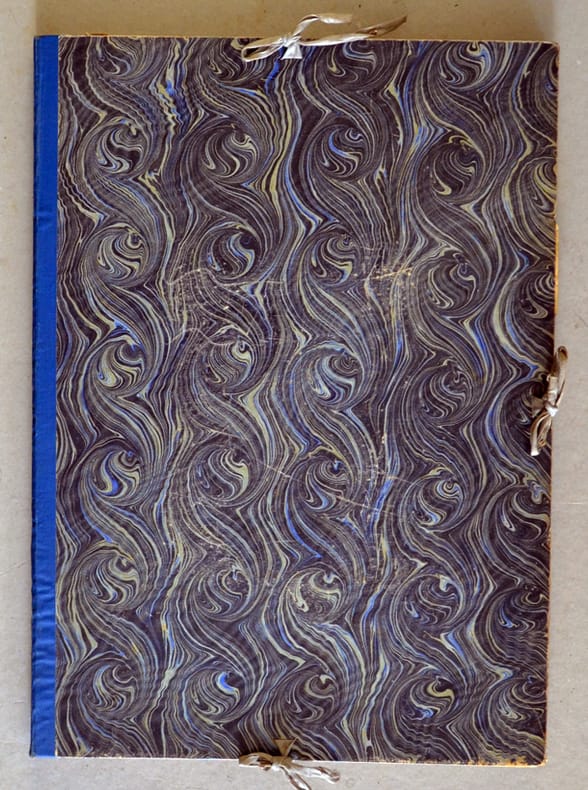
|
|
|
GRAVURE [DAULLÉ]. DELIGNIERES (Emile)
Catalogue raisonné de l'œuvre gravé de Jean Daullé d'Abbeville.
Paris, Rapilly, 1873. In-8, bradel demi-percaline rouge, dos titré, couv. conservée (rel. postérieure), [2]ff.-XXVII-138 pp. Edition originale.
书商的参考编号 : 568064
|
|
|
GRASSET de SAINT SAUVEUR Jacques (GRAVURE)
Chef de l'isle de Ste Christine.
1788 1788 Gravure a l'aquatinte du 18e siecle (1788) par Labrousse, d'apres le dessin de Grasset St Sauveur, Coloriee a la main a l'époque.Encyclopédie des voyages,Kolorierte Aquatinta, Darstellung: 11 x 17 cm
书商的参考编号 : 17271
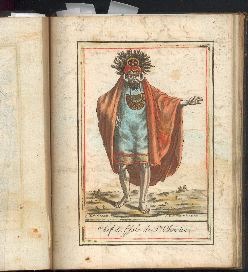
|
|
|
Grandville & E.Forest.-
Cérémonie des cendres politiques. (Suite) Lithographie, Coloriée Hand-coloured lithograph,-
1833 Planche HT parue dans La Caricature politique, morale, littéraire et scénique, volume 5, 28 février 1833 (Planche n°250) - Hauteur: 27.3cm x Largeur: 35.8cmDimensions - Image :Hauteur: 20cmx Largeur: 28cmTitre en ht au centre : « Cérémonie des cendres politiques. // (Suite) » ; légendes en bas, de gche à dte: « Pere [Père]-Scie, // ange de la morgue. », « Madrier-Longeau, // Girafe. », « Nargout », « Guizotin // doctrinain. », « Berthe en poissarde », « Bey-dok en marlou. », « Chonaine et // Stephanus // ivres…de joie. », « leur valet // en Figaro. », « M. Vienn.. », « Air du déserteur », et, sous une partition de musique : « Le roi pas-sait [passait] etc etc » ; indications : en ht à dte : « La Caricature (Journal) Pl. 250 // N°121. »Inscription - Dans la lettre : « L. de Becquet, rue Childebert N°9. » [imprimeur], « On s’abonne chez Aubert, galerie véro dodat. » ; dans l’image, en bas à gche, signature : « JJ. Grandville // E. Forest » [Jean-Jacques Grandville, dessinateur, et Eugène Forest, lithographe]Pl. n°2 de la série "Cérémonie des cendres politiques". Cf. pl. n°1 (pl. 248 du numéro 120) et pl. n°3 (pl. 251 du numéro 121). Suite du cortège dans lequel on peut reconnaître : Persil en bourreau, affublé d’un grand nez en forme de scie dont le bout est rougi par le sang, portant la coiffe de magistrat, portant un tablier de boucher où apparaît le portrait d’un homme et sur lequel peut se lire « PEINE // DE // MORT // TOUJOURS ! // 5000000000000 // AMENDES ». Il porte une hache de la main dte (décorée d’une poire), tandis que sa main gche est salie par du sang. Madier de Montjau chevauche une fausse girafe pourve de deux jambes d’hommes montées sur des échasses. La girafe est couverte par un carapaçon orné du motif de la poire à face humaine (Louis-Philippe). D’Argout en polichinelle vient ensuite, son costume ayant pris la forme de son grand nez au niveau du buste. Puis Guizot, en ecclésiastique tenant un petit ouvrage ouvert, fervent défenseur de la doctrine, « Berthe en poissarde », « Bey-dok en marlou » (identification difficile de ces deux personnages), puis Schonen, et la figure du "Constitutionnel", soutenu par l’incarnation du journal "Le Figaro" lequel, partageant depuis 1832 les idées du gouvernement, se fait maintenant le soutien de ses membres (« veut les relever de la boue dans laquelle il les a traînés si longtemps » in explication). Se trouve ensuite Viennet récitant des airs d’orgue de Barbarie décoré d’un motif de poire. La pl. se moque de son activité de poète.
书商的参考编号 : 25196

|
|
|
Grandville , Forest, Eugène-Hippolyte
Digestion du Budjet ; travail administratif, politique, moral et surtout économique.- Lithographie sur blanc.
Planche HT parue dans La Caricature morale, religieuse, littéraire et scénique, volume 4, 24 mai 1832 (Planche n°165)- Lithographie - Œuvre: Hauteur: 27cmx Largeur: 35.6cm - Image: Hauteur: 16.9cmx Largeur: 30.9cm - Titre en bas au centre : « Digestion du Bugjet [Budget] // travail administratif, politique, moral et surtout économique. » ; indications, en ht au centre : « La Caricature (Journal.) // (N°82) », en ht à dte : « Pl. 165. »Inscription - Dans la lettre : « Lith. de Becquet, rue Childebert N°9. » [imprimeur], « On s’abonne chez Aubert, galerie véro dodat. » [éditeur] ; dans l’image, en bas à gche, signature : « J.J.G.E.F. » [Jean-Jacques Grandville, dessinateur, et Eugène Forest, lithographe]Inscription - Sur les liasses de feuilles en bas à gche, inscriptions : « CHATEA [CHATEAUX] », « DOTATIONS // N°150 [ ?] », [ ?] PROVISOIRE » ; sur la trappe ouverte à dte, inscription : « FONDS SECRETS »
书商的参考编号 : 25636
|
|
|
Grandville , Forest, Eugène-Hippolyte
Donnez moi la première chose venue Lithographie sur blanc.
Planche HT parue dans La Caricature politique, morale, littéraire et scénique, volume 4, 11 octobre1832 (Planche n°208)- Lithographie,pli central - ŒuvreHauteur: 27cmx Largeur: 35.6cm - Image: Hauteur: 24.6cmx Largeur: 18.4cm - Titre en bas au centre : « Donnez moi la première chose venue » ; légende plus bas au centre : « (La scène se passe chez le Pharmacien royal. – il s’agit // de composer un remède.) » ; indications, en ht au centre : « La Caricature (Journal) // (N°101) », en ht à dte : « Pl. 208. » - Dans la lettre : « Lith. de Becquet, rue Childebert n°9. » [imprimeur], « On s’abonne chez Aubert, Galerie véro dodat. » [éditeur] ; dans l’image, en bas à dte, signature : « JJ. G. E. F. » [Jean-Jacques Grandville, dessinateur, et Eugène Forest, lithographe]Inscription - Dans le coin inf gche, deux bouteilles de « SUCS // PROTOCOLES », et un bouquet d’herbes dans un sachet portant l’inscription : « DORMITIFS ». Sur le mur du fond, à gche, un « BAROMETRE » de l’ « Enthousiasme » portant les mesures : « République », « Glace », « Froid », « Temperé [Tempéré] », « Chaud », « à son comble ». Un petit garde national, bras droit tendu sur le côté, sert d’indicateur. Sur les bocaux rangés sur les étagères au fond : de « huile // d’Amendes // Douces » contenant une amende de « mille francs », du « Medium » contenant une poire, une « Liste Civile // 1832 », de l’ « OR », du « Dupinium // Sel neutre » contenant la figure de Dupin, de l’« Ex-Carbonaro » contenant le buste de Barthe, du « Sel Marin // neutralisé », de l’ « Eau des os », du « Sulfate d’oxygène // Désoxigéné [Désoxygéné] » contenant le baron Louis de profil en pied maintenant un portefeuille (portant l’inscription « FINANCE » sous son bras), du « Vernis Copal » contenant d’Argout de profil en pied maintenant aussi un portefeuille, du « Broglium // Aristocratisé » (duc de Broglie), du « Guizotinium // Caput mortum » (Guizot). Sur la table, d’autres bocaux de « Graine // de lin », de « Mars oxidé [oxydé] », de l’ « Extrait // de // Mercure » contenant une petit figure de Thiers, de l’ « Huile // Essencielle [Essentielle] // d’Alsace » (Georges Humann), et un billet de « PILULE [PILULES] DOREES ». Une poire en guise de bouchon ferme la fiole de la « Potion selon // la Formule » de la « PENSEE // DU 13 // MARS » (ex-gouvernement de Périer). Sous la table sur laquelle repose cette fiole, se trouve un alambic contenant du « Residu [Résidu] // de l’Etat // de Siege [Siège] ». Non loin est posé par terre un récipient d’ « Essence // Légitimité ». Sur le flanc de la table de préparation sont placardés les uns sur les autres des billets : « Ordonnance // Octtob […] [Octobre] 1832 », « Police // Dissolution », « AMENDES // PRISON »
书商的参考编号 : 25639
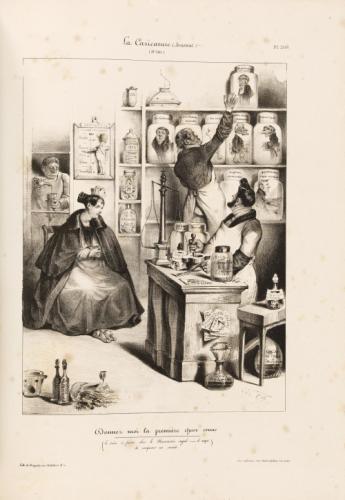
|
|
|